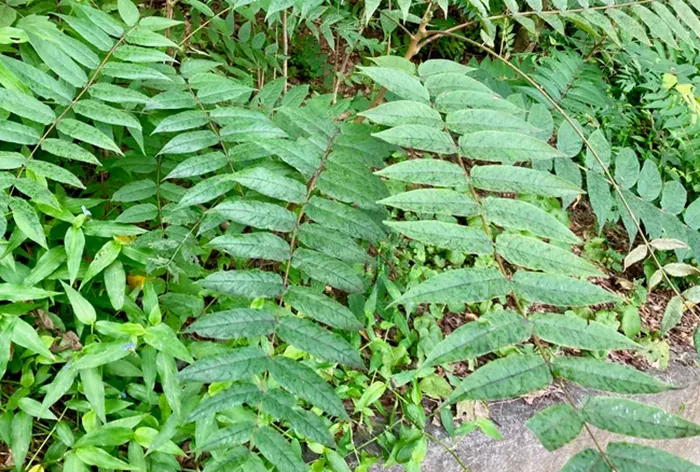Invasive plants are a growing concern in the Charles C. Deam Wilderness. Efforts are underway to identify and document these plants, which are also found in local gardens and yards.
For the past two years, staff from the Hoosier National Forest and the nonprofit State of Indiana Cooperative Invasive Management (SICIM) have explored Indiana’s only wilderness to map the locations of invasive species. In 2023, they focused on hiking the 36 miles of trails in the Deam Wilderness, searching for invasive plants within 25 feet on either side of the path. This year, their work has centered around Frog Pond Ridge, which features unique limestone outcroppings and potentially rare plant life.
Cheryl Coon, the economic partnership coordinator and former botanist for the Hoosier National Forest, noted that the group hired Eco Logic, a Bloomington-based organization, to assist in mapping the various invasive species.
“We need to understand what we’re dealing with if we want to manage these plants effectively,” Coon explained regarding the non-native and aggressive flora.
The Spread of Invasive Plants
While the mapping began along the trails, Coon and her team are aware that invasive plants exist throughout the wilderness. These species spread not only through foot traffic but also by seeds carried by birds and other wildlife or blown in by the wind. Some may have originated from remnants of farmsteads that once occupied the area.
The initial focus on trails serves a purpose. “We want to remove invasive plants from trails to prevent people from spreading them further,” Coon said. She added that horses also contribute to the spread of invasive seeds along trails and across streams.
The Deam Wilderness covers 12,953 acres. Before the current mapping project began in 2023, volunteers, along with Indiana University professors and students, spent time removing garlic mustard, a problematic invasive plant. These groups have been working for over 15 years to clear invasive species, significantly reducing their presence in the wilderness.
Monroe County Identify and Reduce Invasive Species (MC-IRIS) has collaborated with Indiana University groups for the last four years, focusing on Japanese stiltgrass along several trails. This species is the most common invasive found along the trails in the wilderness. Japanese stiltgrass thrives in young forests and shaded areas, making it particularly invasive.
Notable Invasive Species Identified
Several invasive plants have been documented in the Deam Wilderness:
Amur honeysuckle: Found in several locations along trails.
Autumn olive: Scattered along many trails, with varying concentrations.
Burning bush: Located in three spots in the eastern wilderness.
Callery pear trees: Found in two locations on a single trail.
Garlic mustard: Detected in four areas, though reduced due to past removal efforts.
Japanese barberry: Present in a few places along trails.
Japanese honeysuckle: Found along many trails in numerous locations.
Japanese stiltgrass: The most prevalent invasive plant in the area, with widespread distribution.
Multiflora rose: Found abundantly along all wilderness trails.
Tree of heaven, poison hemlock, privet, and several others: Documented in various locations.
However, two species, lesser celandine and Siberian squill, were not found during the mapping process. Additional invasive plants like Oriental lady’s thumb and beefsteak plant were observed but not mapped, as they did not appear to be spreading.
Challenges of Eradicating Invasive Plants
Working in a designated wilderness area poses challenges for controlling invasive species. Herbicides, commonly used in other parts of the Hoosier National Forest, are prohibited in this area. While plants like garlic mustard and Japanese stiltgrass can be pulled, others, such as tree of heaven and wineberry, must be cut and removed.
Teena Ligman, a co-founder and board member of SICIM, stated that without herbicides, controlling certain invasive plants becomes “a losing battle.” Gaining approval to use herbicides would be a lengthy process, requiring proposals and public hearings.
SICIM president Anthony Sipes concurs, emphasizing the need for a comprehensive environmental analysis before seeking herbicide use. Meanwhile, groups and volunteers will continue to locate and eradicate as many invasive plants as possible using allowed methods.
Future Efforts and Funding
Looking ahead, project leaders hope to secure additional funding to expand their work in 2025. Funding for 2023 came from a U.S. Forest Service grant and the Inflation Reduction Act.
If funding is available next year, efforts will focus on tree of heaven and wineberry, two rapidly spreading invasive plants. The tree of heaven is particularly concerning, as it is favored by the spotted lanternfly, an invasive insect threatening crops and trees across the U.S.
Sipes explained that tree of heaven and wineberry were likely introduced by subsistence farmers who previously inhabited the wilderness area. Since they are currently limited in their spread, eradicating them soon could prevent further encroachment. “We could get ahead of them,” he said. “They’re out there but not everywhere, which means we have a chance to manage them effectively.”
Related topics:
- Minocqua Florist Spreads Joy by Giving Out Flowers in ‘Petal It Forward’ Initiative
- Pollen Wars: How Plants Compete for Space on Pollinators
- Ways to Shield Your Plants from Cold Weather


